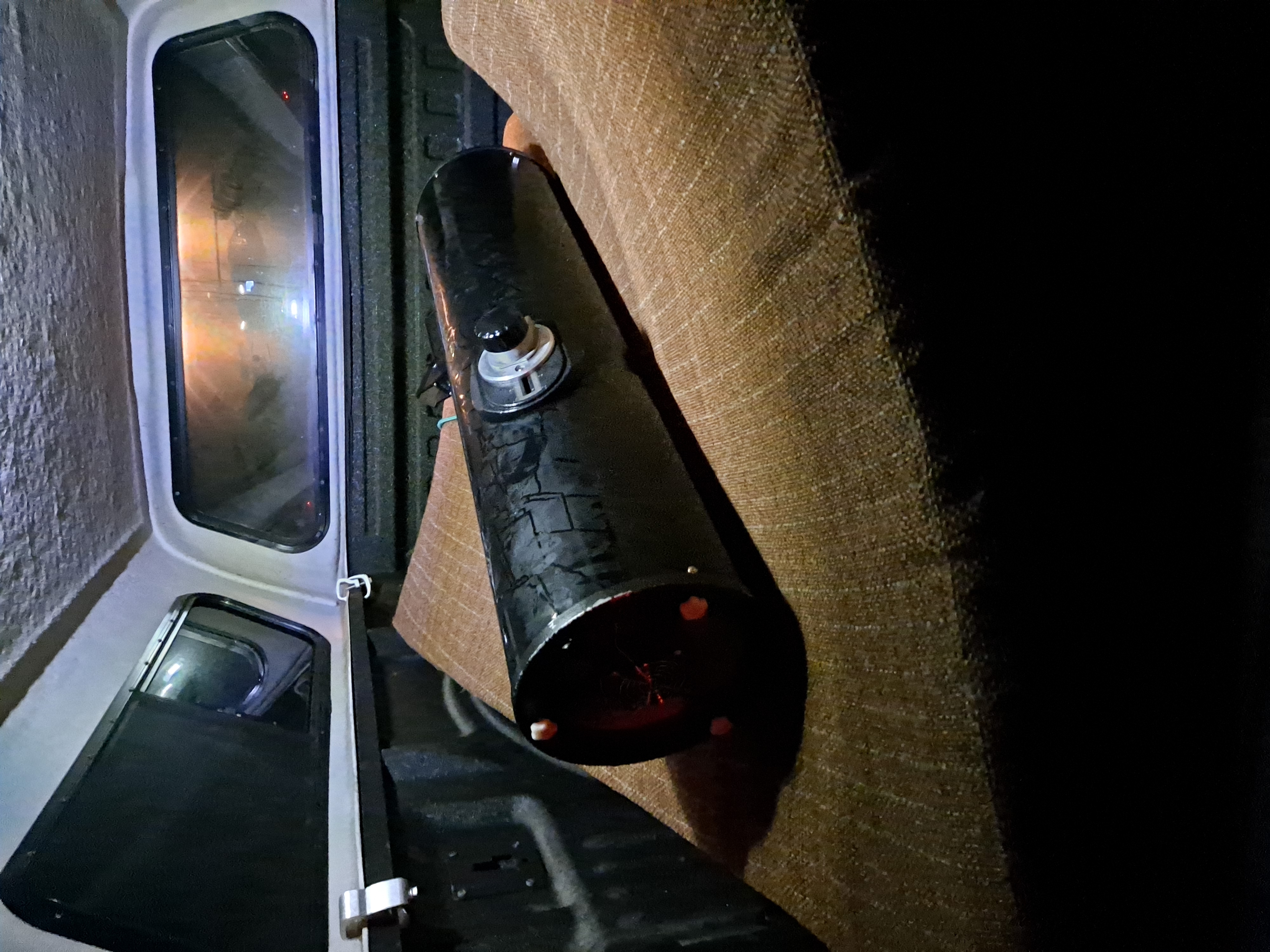If you’ve started shopping for a telescope, you’ve probably noticed a huge range of prices. You might be wondering how much you need to spend, what the difference is between a cheap and expensive telescope, and how well it will hold its value should you decide to sell it down the road. In this article I’ll try to clear up some of these questions and help guide you to a decision that you’ll feel good about.
Telescopes hold their value very well, and sell used for between 60-100% of their retail value. There is a high demand for telescopes and they are expensive. Telescopes sell well on local marketplaces, but more expensive, specialized may sell better and for a higher price on national Astronomy specific selling platforms.
If you are concerned about the resale of a telescope, research the local market before you purchase a telescope. See how much similar telescopes are selling for in your area or nationally if you are comfortable shipping.
How Much Should You Spend on a Telescope?
This is the first big question for anyone looking to buy.
First-time buyers in particular, or people buying for children, are likely to set their budget as low as possible, often $100 or less. I suppose the idea is to test the waters before committing to the hobby.
This approach is usually a mistake, since there are few telescopes worth buying in this price category. This is the realm of the department-store scope: thin refractors on wobbly mounts, or stubby little tabletop reflectors. You can read more of my thoughts on budget in this post.
These telescopes can suffice for viewing the moon but seldom give satisfying views of anything else.

The good news is that for a little more money you can get a much better instrument.
The tried-and-true Dobsonian reflectors start at around $300 with the ultra-portable Sky-watcher Heritage series. $500 will get you a very capable 8-inch model, if you can handle the larger size of these telescopes. There are other, more traditional-looking models such as Explore Scientific FirstLight and Meade StarPro refractors in the $300 range as well. ‘
Going from $100 to $300, the difference in quality is substantial. You will find the more expensive scope sturdier. The views will be brighter and sharper. The scope will be easier to aim and will generally stay where you point it. It will come with better hardware and accessories. In short, it will be more fun to use.
While it is important to get the right scope, many things can ruin the hobby for you. Be sure to read our guide to avoiding “Hobby Killers” here.
Is an Expensive Telescope Worth It?
This one is a little harder to answer, as people have different definitions of “expensive” and “worth it”. There are three main factors which impact the cost of a telescope:
Aperture:
This is a measure of how large and powerful a telescope is.
All other things being equal, a telescope with a larger aperture will see more detail and show brighter images than a smaller aperture. It will also be bigger, heavier, and more expensive. “Aperture fever” is the condition of always wanting a bigger, more powerful telescope.
Optics:
The quality of the glass and coatings used in the objective lens or primary mirror can have a major impact on the cost of a telescope. This is especially true of apochromatic refractors with triplet lenses made of exotic glass.
First-time buyers generally don’t need to worry about this, as the optical quality of cheaper telescopes is usually sufficient for casual viewing.
Electronics:
In this modern age everything is computerized, and telescopes are no exception.
A telescope with a computerized mount can locate and track thousands of objects once it is initialized and aligned with a few stars. Many are also Wi-Fi compatible and can connect to your phone for easy control. But such electronic components add cost to the scope.
A computerized kit under $300 is not likely to be of good quality, since the manufacturer would have made other compromises to keep the cost down.

Putting all this together, you can see that a large-aperture telescope with high-quality optics and a computerized mount will be expensive, easily in the thousands. In addition to which it will be heavy and require some special care.
Choosing a telescope is mostly about trade-offs.
When I was shopping for my first scope, I knew I wanted an aperture large enough for good deep-sky viewing. I also liked the idea of a computerized mount; therefore, the Celestron NexStar 8Se was a top contender. But it was also $1500CAD, which was over my budget.
In the end I opted for an Orion SkyQuest XT8 Classic, which has the same 8-inch aperture but is manually operated. This decision saved me about a thousand bucks.
Do Telescopes Hold Their Value?
People sell telescopes for all sorts of reasons.
Probably the top two are because they are upgrading, or abandoning the hobby. With either of these possibilities in mind, you might be wondering how fast your new toy will depreciate once you carry it out of the store.
Telescopes hold their value well, you can expect to sell your quality telescope for 70% or more of their retail value. Used telescopes are in high demand. Telescopes in the $300-$1000, are selling very well on the used market. If you are selling a very low cost, lower quality telescope you may have trouble selling it because there are so many more on the market.
At the time of writing, telescopes are holding their value extremely well. That’s because of high demand and limited supply, both due in large part to the global pandemic. It’s a seller’s market if there ever was one.
Pandemics aside, there is usually a robust market for used telescopes. Correction: for good used telescopes. A quick browse through your favorite classifieds site will reveal piles of poor-quality scopes, many of them selling for close to full retail.
If you buy a telescope in the sub-$200 range and then need to sell it, you might find yourself in a crowded market of unwanted telescopes.
Once you get into more popular and proven models, such as Sky-Watcher Dobsonians and Celestron NexStar, the situation is quite different.
People actively seek these scopes out.
In good condition, you might get 75% of their retail value or more. Likewise for apochromatic refractors and SCTs. Of course, the more aggressively you price a telescope, the more likely you are to sell it quickly. Much depends on the demand for the brand or type you are selling, as well as where you post it.
If you are concerned about resale, research the market in your area and see how much similar items are asking. Note how long the ads have been up and decide how long you’re willing to wait for a sale. Take good pictures of what you’re selling. Be sure to list any accessories. Include an enticing description of the telescope, not just a copied-and-pasted blurb from a website.

Where Should You Sell a Telescope?
Depending on what type of telescope you are trying to sell, you might not want to be bothered with shipping it. Or maybe you aren’t comfortable with a long-distance transaction. Either way, offering it in social media groups and local online classifieds is a good start.
I bought an expensive reflector from Kijiji, the Canadian equivalent of Craigslist, and have sold telescopes on Marketplace. If nothing else, this eliminates the risk of dealing with shipping damage or lost packages.
On the other hand, your chances of making a sale are much greater if you post it on an astronomy-specific, nationwide classifieds site.
This is especially true of more expensive or specialized equipment such as astrophotography gear or a heavy-duty mount.
In the USA, Astromart and Cloudy Nights are the websites of choice, but be aware that you will need to sign up for Cloudy Nights and pay a subscription fee for Astromart. In Canada and the UK you have Astro Buy Sell, which I have used extensively.
Look for a site with a lot of activity and be sure to note any scam warnings or fraud notices posted on the home page.
.
Finally, you can always try selling or trading in your equipment to an authorized dealer. While I haven’t done this myself, common sense suggests that you will get a significantly smaller return for the convenience of a quick sale. The dealer needs to make their buck, after all.
Shipping a Telescope
If you decide to ship to a buyer, here are some ways to ensure the long-distance transaction goes smoothly:
- Negotiate the shipping rate beforehand. Use online rate estimates from various courier websites to get a realistic idea of the cost. Consider sharing the shipping cost if the buyer seems on the fence about the purchase.
- Use a sturdy box/carton, new or almost new. There should be no tears and the corners should not be worn. The box should be bigger than the telescope to allow for packing materials, but not oversized as this will drive up shipping costs.
- Use bubble wrap, air pillows, and other carton fill to protect the scope. Nothing should move inside the carton if you shake it after it is sealed. No part of the telescope should be touching the walls of the carton.
- Seal all seams with a strip of tape at least three or four inches wide. The box should not open easily when you push down on one of the flaps.
- Make sure any shipping labels are affixed firmly to the carton. It’s also a good idea to have paperwork inside with your name and address in case the label peels off.
- Buy insurance!
If storage space allows, you may want to keep the specialized packing that your telescope came in. When Corey bought his first scope, we kept the box and special Styrofoam packing in the attic. He ended up selling it locally, but there is no better packing than what the manufacturer made.




